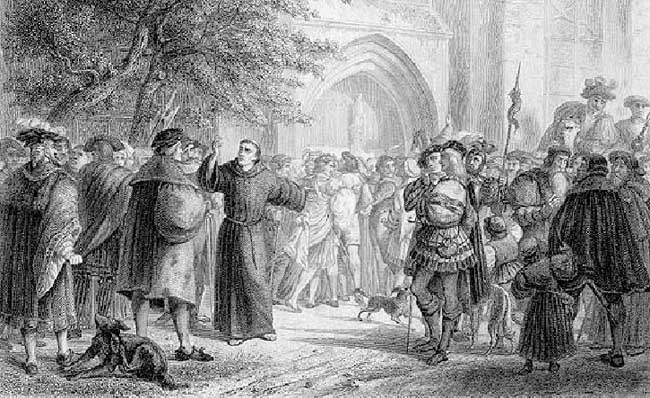Remembering October 31
It is my earnest hope that no reader is going to wonder why this writer wants them to remember Halloween! October 31st, and specifically October 31, 1517, is the date of the beginning of the Protestant Reformation. On this date, an obscure Augustinian monk by the name of Martin Luther nailed ninety-five theses to the church door in Wittenburg, because that was the usual custom of advertisement for the people’s attention. It was the twenty-first century bulletin board. Luther nailed them up at noon sharp because it was the time of the most frequent feasts. Professors, students, and the common people would be coming from all four corners to the church, which was filled up with relics for transfers of credit.
A lot of Protestants, while hearing of this incident of the nailing of ninety-five theses, think that they were ringing endorsements of Protestant theology. In reality, they were more Roman Catholic than Protestant. There is no protest against the Pope and the Roman Catholic church, or any of her doctrines, not even against indulgences. They were silent about justification by faith alone. They were primarily opposed to the abuse of indulgences.
But while the form is Romish, the spirit and aim is Protestant. They represent a state of transition between twilight and daylight. We must read between the lines, as the leaders of the Roman Catholic church did in the sixteenth century. As they did, they saw a logical drift which sought to undermine the whole fabric of Romanism.
Luther hoped that there would be a scholarly debate of the abuse of indulgences. But no one came to debate him. Instead, with the recent invention of the printing press, the copies of the ninety-five theses were sent all over the empire. The pope had a copy within two weeks. The common people read them and rejoiced over them. Luther was the talk of Germany. There was a trumpet call being sounded for what later on became the Protestant Reformation.
Words to live by: In less than five years, in 2017, we will celebrate the five-hundredeth anniversary of the Protestant Reformation. Will there be a revival of its themes in your church and more important, in your heart, such as Scripture alone, Christ alone, Grace Alone, Faith Alone, and Only to the Glory of God? That sums up what Luther, and Calvin, and Knox thundered to the masses and the visible church. Reflect on the story of Martin Luther and the Protestant Reformation in your heart, home, and church.
What better reason for remembering this day. No, not Halloween. Rather, October 31st, and specifically October 31, 1517, as it marks the date of the beginning of the Protestant Reformation. On this date, an obscure Augustinian monk by the name of Martin Luther nailed ninety-five theses to the church door in Wittenburg, because that was the usual custom of advertisement for the people’s attention. It was in effect a public bulletin board. Luther nailed the document up at noon sharp because that was the time of the most frequent feasts. Professors, students, and the common people would be coming from all four corners to the church on “All Saints Day,” for that was a time when it was filled up with relics for transfers of credit or “merit” under the Roman Catholic system.

